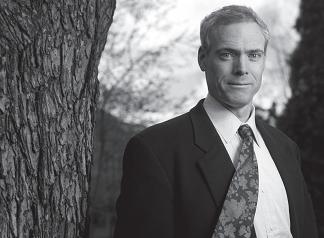Simon Chadwick
First published in Research World May 2010
Simon Chadwick talks to Jim Collins, best-selling author of Built to Last, Good to Great and How the Mighty Fall, about what makes a truly great company stand out.
Jim, in Good to Great an early conclusion of yours was that most CEOs of great companies are in fact very humble people. Do you think that Wall Street and the media make it harder for boards to deliberately choose self-effacing but effective leaders?
First of all, we weren’t looking for this finding when we did the Good to Great research. We set out to study what kinds of leaders, or what their characteristics were, that enabled companies to take something average and turn it into something exceptional and to make a leap in performance that lasted at least 15 years. As we got into the research we were struck by the leaders of those companies and the absence of the types of traits that you would normally think of relating to great corporate leadership. What we found was this interesting blend of personal humility and professional will that drove them.
The real key here is not personality, in fact, most of them were not charismatic. Our empirical finding was that these people were ambitious – first and foremost for the cause, for the company, and for the work, but not for themselves, and they had this incredible will to make good on it. Boards of directors and people looking in from the outside can be very easily seduced by the need for a great ‘Rock Star’ leader, while they probably ought to pay attention to the fact that this is rarely a successful strategy.
Over 90% of the Good to Great CEOs came from deep inside their own companies. And over two-thirds of the companies that tried to make the leap from good to great, but failed to do so, or did but failed to sustain it, tried the ‘outside saviour’ model and failed to become great.
Each of these companies found a core principle or reason for being, which you lay out in Good to Great as the ‘hedgehog principle’ or the ‘three circles’. Can you explain why it’s difficult for companies to achieve this, and even more to adhere to?
Well, with the three circles, we zoom out and ask the question, ‘How did they bring about these transitions from a good enterprise to a great one?’ And it broke into three stages.
You had disciplined people, very special leaders who got great people around them, and disciplined thought followed by disciplined action. Right in the middle of that is coming to a penetrating understanding of three intersecting circles, and that’s where the attention is focused. Those three circles are passion, investment and economics.
Imagine if, as a person, you were able to channel your energies (a) into things that you’re deeply passionate about and that you love to do: Circle 1, and (b) that you have a great genetic talent for and (c) you’re able to make a living doing it. Now if you can marry those three: passion, genetic encoding, and making a living, it’s a very good place to be.
What we found in our companies is a sort of scaled-up version of that. They found what they were passionate about, and that fit with their core values; second, a hard-headed data-driven understanding of what they could absolutely be the best in the world at which went hand-in-hand with great clarity about what you cannot be the best at.
And then third, they came to a deep understanding of what truly drives their economic engine. Take for example Walgreens, which took off when they got their hedgehog concept clear – they’re still living with that concept 35 years later. The concept was simple: it was to be the best, most convenient drugstore, constantly increasing improving the way they do things so that every time somebody comes in, they increase the profit per customer visit.
A real, honest, and ultimately very humble understanding of what you can and most importantly cannot be the best at involves a penetrating understanding based on evidence and data of what you truly can be. It’s probably one of the reasons why a group like the readers of this publication, who are involved in the collection of data and interacting in a very qualitative way with customers, have a critical potential role in helping to gain that understanding.
Why it’s hard for companies to follow this is very simple. It requires having the discipline not of what to do but of what not to do, and what to stop doing. We found that what our leaders were really good at was not setting out, ‘Here are ten things we’re going to do this year’, but ‘Here are the five things we’ve discovered do not fit with our concept, and we will stop doing them even if they would produce great growth. Even though there’s growth and potential in it, we can’t be the best at it, we’re not passionate about it, and it doesn’t fit with what drives our economic engine.’
You talk about the potential position of researchers as providers of quantitative data and evidence. What role do data and evidence have in distinguishing good from great and failure from success?
Well, first I have to underscore that there’s few things in life that I love more than research, and pretty much in everything I do, I try to go back to some sort of an evidence-based view of the world.
But if you stand back and ask yourself: ‘What really distinguishes the great strategies from those that end up not working in the end?’, the answer is they have a tremendous empirical base behind them.
If you look at when Nucor bet on the mini-mill and then continued to build momentum with it over the course of a number of decades, it didn’t just come out of the air. They’d been gathering information, seeing how the product did well with the customers, and had collected a lot of empirical evidence and data about their success. They asked, ‘why is this working’ and once they understood why, they could replicate it. What we find is that to craft an intelligent direction, it’s ultimately not a process of visionary dreamy objectives, but of hard-nosed empirical foundations.
Data and evidence play a key role in helping to sustain momentum and to give people a wind behind what they’re trying to do.
I was struck, in How the Mighty Fall, by the fact that you said “Technology, the possession of or lack of, is rarely a factor in either success or failure per se”, and that it can be an accelerator or a decelerator. Could you comment?
Well first of all, as Clay Christensen observed, what’s scary is that disruption is not instantaneous, it’s gradual. The actual impact of it may feel instantaneous, but it’s not, it’s the denial of the cumulative effect of things sneaking up on you.
Similarly, in How the Mighty Fall, the fall of a company doesn’t happen instantaneously and doesn’t come out of nowhere. There are certain types of technologies that are almost always a long time coming.
What you find through the lens of successful corporations is how they grab the right technologies for them, they may even be late to the game in using them, but the key is that they harness them back to what they’re passionate about, what they’re the best at and what drives their economic engine. And they use it as an amplifier and an accelerator.
If you are wiped out by some unforeseen disruption, it is usually because you have lost your vigilance and have mismanaged yourself as a company, rather than that the technology itself brought you down. Some companies are able to go through many cycles of technologies, products and markets. In fact, 15 of the 18 companies in Built to Last lived through the 1930s depression and all 18 of the companies that we selected in 1989 are still stand-alone companies today.
And yet there’s been tremendous technology change, tremendous product change and tremendous market change. You build the company around some consistent principles, but in order to evolve you must be willing to change your technologies and your products and your strategies, as the world around you changes.
One of the things that you stress is that what you call ‘level-fine leadership’ does mean confronting the brutal fact of reality. How many companies do you think seek out and acknowledge reality, rather than just seeing the world through their own prisms?
We talked earlier about disciplined people leading to disciplined thought and then taking disciplined action, but the first part of this is the ability to confront the stark brutal facts that you face.
What often happens is that people choose to deny the facts. If you look at both Good to Great and How the Mighty Fall, what you find is that there’s a positive inflection point and a negative inflection point. But the pivot point in both is this notion of confronting the brutal facts. The ‘Stage Three’, which is just before you fall in How the Mighty Fall, is denial of risk and peril. And it’s usually denying facts that are right in front of you.
Now, if it’s ambiguous, how do you deal with it? You should always interpret it as negative if you can because this will protect you better. In Good to Great, on the positive inflection, you see that what is critical right before the company takes off, is confronting the brutal facts. So, if you’re a successful company and you refuse to confront the brutal facts, you can bring about a negative or a positive inflection. Why do people deny what’s right in front of them? That, I think, is one of the great mysteries of human history.
I believe that brands are a company’s physical and emotional connection to the customer. What, if any, conclusions did you reach about the importance of brands in Good to Great, or indeed, the reverse?
First of all, I share with you a belief in the power of brands, but the critical idea about what makes an enduring great company is an underlying inter-duality that we call ‘preserve the core and stimulate progress’. Any great institution has a core that has tremendous continuity – a set of values and a reason for being that remains constant over time. But also, to the world around it, it stimulates progress, changing its practices, methods, strategies and ways of doing things – even changing the business that it’s in. So this notion of ‘preserve the core and stimulate progress’ is the secret of a truly enduring great institution.
So I think the idea I would suggest here is that an enduring great company that preserves its own core and constantly stimulates progress will tend to project an enduring great brand.
What makes a brand very powerful is having a core brand promise that remains consistent over time, but changing the packaging and the themes. Look at the Coke, Disney, or Starbucks brands, they are evolving constantly – but the core brand promise remains consistent.
We can’t use the same packaging or the same advertising, it’s a different era, it’s a different generation, with different ways of reaching people – but what remains constant is ‘Preserve the core, stimulate progress’.
Listen to the full audiocast here.
Jim Collins is author of Built to Last, Good to Great: Why Some Companies Make the Leap… And Others Don’t, and How the Mighty Fall: And Why Some Companies Never Give In.



